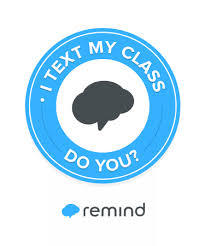Randi Zuckerberg's Blog, page 27
August 19, 2015
Radio Recap: Wedding Tech
 Currently weddings are a $300 billion dollar global industry employing over 800,000 people in the United States alone. And now, with the recent legalization of gay marriage in all 50 states, the marriage business is set to gain another $2.5 billion dollars annually. So if technology has made our lives easier, more efficient, and more cost effective, what has it done for the wedding industry to help create that magical day?
Currently weddings are a $300 billion dollar global industry employing over 800,000 people in the United States alone. And now, with the recent legalization of gay marriage in all 50 states, the marriage business is set to gain another $2.5 billion dollars annually. So if technology has made our lives easier, more efficient, and more cost effective, what has it done for the wedding industry to help create that magical day?
Randi discussed how to disrupt your own wedding with the latest in wedding technology with Naa-Sakle Akuete, the who nailed her dream wedding by spending only $10,000, and Carolyn Gerin, the co-founder of the WedTech Summit, an annual wedding and technology conference.
NAA-SAKLE AKUETE
“My now-husband and I met on OKCupid so we were more used to the internet facilitating our daily lives.”
“We were looking for locations but they wanted $15,000. So the first thing we did was go to Airbnb. You can use the app to find places that cater to events and bring your own food to.”
“A wedding planner would’ve been our entire budget.”
“After we went the Airbnb route everything else fell into place.”
“When you rent a space, both Airbnb and the host are insured—I think.”
“I was afraid of bothering people too much so I sent out a save-the-date and an invite through Paperless Post. If I were to do it over again, I would’ve followed up more.”
“I have friends who went the traditional paper-invite route. It’s beautiful but it’s so expensive.”
“The website we set up was through TheKnot.com but I would use Squarespace if I had to it again.“
“Our registry was on Amazon and most of our friends have Prime so it was pretty easy. Plus they have student pricing.”
“TaskRabbit is essentially the Craigslist of services. We set up tasks for photographers for only a few hundred dollars.”
“We hired a cook for the Sunday brunch and a cleaning crew all through TaskRabbit.”
“I haven’t done grocery shopping in a year because I use Instacart.”
“For the wedding we used Costco, which was nice using Instacart because we don’t have a membership.”
“I didn’t hear about Instacart until a month before our wedding. It revolutionized our wedding.”
“When JCrew had the 75% off sale my dress was already sold out, so I bought it on eBay.”
“My husband still makes fun of me for using a Google spreadsheet. But it helped us keep everything on time.”
“We met on OKCupid. It’s fun because they ask you a ton of random questions. They also let you filter things specifically.”
“Eu’Genia Shea is named after my mother who was already in the shea butter business.”
“After telling your parents and friends about your engagement, the first question anyone’s going to ask you is what’s the date?”
“Talk to your partner about the budget. My husband asked why we needed lights. Things as basic as that cost a lot of money.”
“We borrowed a couple GoPros and set them up around the house but it ended up looking like security footage.”
“We assumed everyone had their own phones and could take their own photos. PictoBook gathered the photos and made us a wedding book.”
“We used Spotify for music. Anytime we heard a song that would make us dance we’d add it to the playlist.”
“If you have a hashtag wedding then you’re taking guests out of the moment since they have a task.”
“Google Maps has an option to track your friends. So I could track my mom or husband. Not in a creepy way.”
Find out more about Naa-Sakle HERE.
CAROLYN GERIN
“Weddings are a very traditional industry and is one of the last industries to meld tech into it.”
“Wedding brands, event planners, vendors all come together at the WedTech Summit.”
“Platforms like Honeybook and AislePlanner take the brutality out of event planning.”
“Wix.com saves the engaged couple from asking a bunch of questions like where’s the wedding, the registry.”
“Bridal analytics on how digitally engaged couples use tech are helping open the wedtech space.”
“We’re Ground Zero for same-sex marriage. It’s going to open the wedtech marketplace in a huge way.”
“Pinterest is really driving gay weddings because everyone is putting together original boards.”
“An anti-bride is about having fun and doing what you want with your own style. One-size-fits-all weddings are a thing of the past.”
“If you’ve got Branson money and want to shoot yourself into space, then that’s pretty out of the box. But weddings shouldn’t put you in the hole.”
“You need to be solving a problem in the wedding space. Take the stress out of the wedding.”
“Millennials want to take their needs online. Weddings need to adapt to that.”
“JCrew was ahead of the game with wedding dresses. You could be a size 12 lactating mom or a size 2 Bikram girl, and JCrew has that.”
“First pick a date around the location then build your website.”
“Video drones are a huge trend at weddings.”
“I like saving time. All of what I’ve seen saves time.”
“Sometimes people share unflattering photos, that’s annoying.”
“I like hashtags because people can find your wedding.”
“EverNote is my everything.”
The WedTech Summit takes place Feb. 22nd & 23rd in Maui of 2016. Buy tickets HERE.
Join ‘Dot Complicated with Randi Zuckerberg’ next week when Millennial reporter Dan Schawbel talks how to market to—and for—Millennials. Only on SiriusXM Business Channel 111 Wednesdays at 9am PT/12pm ET. Call in at 1-800-WHARTON with your questions!!



 by
by 
The post Radio Recap: Wedding Tech appeared first on Dot Complicated.
August 14, 2015
Top 5 Favorite Apps
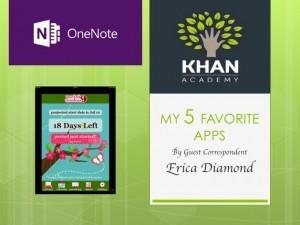 On this week’s back-to-school episode of ‘Dot Complicated with Randi Zuckerberg’ life coach Erica Diamond gave her Top 5 Favorite Apps:
On this week’s back-to-school episode of ‘Dot Complicated with Randi Zuckerberg’ life coach Erica Diamond gave her Top 5 Favorite Apps:
1. One Note
FREE – iOS & Android
Screenshot the schoolyear calendar or your favorite cookbook recipes, clip your kids artwork, report cards, or store design ideas for your bathroom redesign and store it all in the cloud! Think of it also as your camera for the web, so if you’re traveling on a business trip for example, clip and save downloaded web articles for the plane for later reading. You can even scan a business card and import it directly into your address book without typing anything in.
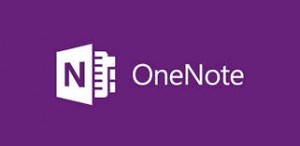
2. Get Off the Fence
FREE – iOS & Android
Kids are back in school so it’s mom’s turn to make an action plan. First, take the pledge to get off the fence right from the app. Then, whatever your goals are—whether they’d be to start a business, get healthy, or have your kids go to bed earlier at night—create your customized monthly off the fence plan to chase your goals. Get daily inspiration right to your smart phone, connect with other fence jumpers, share your Off the Fence story to inspire others, and read our WomenOnTheFence.com blog.
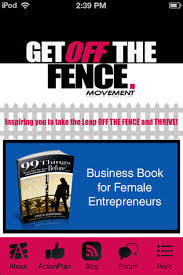
3. Khan Academy
FREE – iOS & Android
“You can learn anything. For free. For everyone. Forever.” Khan Academy’s mission is to provide a free, world‑class education for anyone, anywhere. It’s essentially a personalized learning resource for all ages—we’re talking math, science, economics right from kindergarten up. I first learned about Sal Kahn on ’60 Minutes’, and was completely blown away. Myself and my boys have been loving and watching their videos since.

4. Find My Friends
FREE – iOS & Android
We recently gave my 6th grade son my husband’s old iPhone. He’s started going to the park with his buddies and so I’ve got a new best friend. The Find My Friends App allows me to see where he is and can notify me when he’s left or arrived somewhere. I’m not trying to stalk him or be an annoying helicopter mom, but I like knowing that I have this app if I can’t reach him.
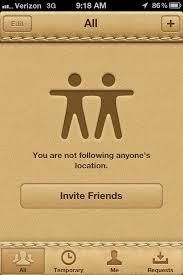
5. Period Tracker
FREE – iOS & Android
All ladies, this one’s a must! I won’t give you all the intricacies of the app, but whether you’re trying to get pregnant (congrats by the way), or trying to avoid getting pregnant (like me), this is every girlfriend’s best friend! I learned about this app on a girl’s night out. A must. And it’s FREE. This app keeps track of ovulation, fertile days, when you’re expecting. This app is every mom’s best friend.

 Erica Diamond is the Founder & Editor-In Chief Women On The Fence®
Erica Diamond is the Founder & Editor-In Chief Women On The Fence® Follow her on Twitter or Facebook.



 by
by 
The post Top 5 Favorite Apps appeared first on Dot Complicated.
August 12, 2015
Radio Recap: Back-to-School Tech
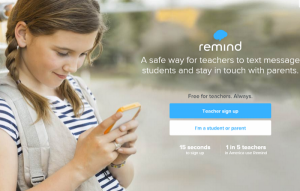 Last year families with two children or more averaged around $650 on back-to-school items. But for 2015 it’s already been estimated that consumers are cutting back, averaging out to about $207 per student—down from $244 in 2014. While U.S. consumers are estimated to spend about $68 billion on back-to-school and back-to-college items this year—down 9% from $75 billion last year—it’s teenagers who are making up the deficit, spending a collective $900 million dollars of their own money on electronics alone. That’s two-thirds of teens and nearly 6 in 10 Millennials.
Last year families with two children or more averaged around $650 on back-to-school items. But for 2015 it’s already been estimated that consumers are cutting back, averaging out to about $207 per student—down from $244 in 2014. While U.S. consumers are estimated to spend about $68 billion on back-to-school and back-to-college items this year—down 9% from $75 billion last year—it’s teenagers who are making up the deficit, spending a collective $900 million dollars of their own money on electronics alone. That’s two-thirds of teens and nearly 6 in 10 Millennials.
The most-desired items from both Millennials and teens? Laptops—followed by wearables, headphones and tablets. So what tech trends can help disrupt education without disrupting the classroom?
Joining Randi on ‘Dot Complicated’ today to discuss the newest in back-to-school trends were Brett Kopf, the CEO and founder of Remind, a secure messaging app that opens up a direct line of communication between educators, parents, and students; and also joining the conversation was Veronica Belmont of ‘Endgadget’s’ tech-advice show Dear Veronica.
“The whole reason I started Remind was because I was diagnosed with learning disabilities.”
“If we can figure out a way to make a teacher’s life easier and get parents to be more active in their kids schooling we’ve done our job.”
“The majority of our growth has happened via word of mouth.”
“Teachers haven’t had access to the best, most simple, mobile technology—yet.”
“Remind allows for motivational messages from teachers saying how proud they are of their students.”
“Teachers use reminders for tests or exams and coaches use it to let players know about weather problems.”
“We’re hoping we can help with snow day info soon.”
“We launched a feature called ‘Chat’ where the teacher can chat with the parent directly efficiently and easy.”
“From the teacher’s perspective, it saves them time to talk directly to the parents. From the student’s perspective, they think it’s cool to get a message on the device they want to communicate on.”
“Parents love to know what’s going on in their children’s education.”
“We have quite a few students with learning disabilities.”
“Remind helps build these tight relationships with parents, students, and educators.”
“I had a teacher in NOLA who told me that before using Remind only 12 out 24 parents showed up to parent-teacher conferences. After he started using it every parent showed up.”
“What parent doesn’t love seeing a photo of their kid climbing on a T-Rex on a field trip?”
“There’s a lot of control we give to the teacher to make their lives easier.”
“If a teacher tries to send a message after 10 pm or before 6 am there’s a notification that pops up saying ‘It’s late, are you sure you want to send this message?’”
“If there’s simple enough technology that can be easily accessed by teachers it can help make the job easier that they have to do.”
“Parents always hear about the bad that technology does. There’s actually a lot of good that tech provides. Our entire company is focused on making it safe and efficient for teachers and parents to communicate.”
“Kids have access to a phone and the internet everyday. The ability to know what to search for is important.”
“All kids learn differently. I would go crazy looking at a text book for an hour.”
“I would love to see more entrepreneurs solve problems for teachers. But they need to listen before just building a bunch of tech.”
“I love the Evernote app. I take all my notes and journal in it.”
“Every kid going to college or high school has a laptop. But wearables are huge.”
“Outside of the classroom services like Khan Academy and Code Academy are great for learning.”
“Kids these days have active social media lives. They post everything online. A lot of it is permanent.”
“It’s important for educators and parents to remind kids that social media posts will follow them for the rest of their professional lives.”
“A lot of teenagers are moving away from sites like Facebook and Twitter where their teachers and parents are. They use Instagram and SnapChat more.”
“The private Instagram messages aren’t as easy to let teachers and parents see what their kids are after.”
“There’s a strange phenomenon called ‘white-walling’ on Facebook. People will have a whole conversation and then delete it so their page is blank.”
“Technology is so engrained in our personal and social lives that I don’t know if withholding tech as punishment would work. Kids may need their laptop for homework.”
“I’ve see kids as young as 6 and 7 getting iPhones. It seems ridiculous but it’s a case by case basis.”
“I had a pager growing up so that was our way of having our parents get in touch with us.”
“People aren’t meeting in the classroom anymore—they’re swiping left and right.”
“The proper channels of communication are very important on how to engage with technology.”
“This is the way that kids are seeing the world now. Stress critical thinking, not just the internet to supplement their education.”
“Listen to educational podcasts with your kids, talk about STEM education.”
“Back in the old days when we did research we used encyclopedias. The internet is so easy to find information but you have to look at it with a critical eye.”
“Reading Rainbow and PBS Kids Go have wonderful apps to get rewarded for learning.”
“I think textbooks are a big issue. At the college level books are very experience and necessary, making it difficult for kids to get them.”
“10% Happier is a guided meditation app based on a book by Dan Harris. I’ve been telling everyone.”
Make sure to join ‘Dot Complicated with Randi Zuckerberg’ next week when she sits down with Carolyn Gerin the co-founder of the WedTech Summit to discuss the newest in wedding technology. Only on SiriusXM Business Channel 111 on Wednesdays 9am PT/12ET.



 by
by 
The post Radio Recap: Back-to-School Tech appeared first on Dot Complicated.
August 10, 2015
Why You Need to Know Your Kids’ Passwords
Our kids are online constantly and most of us have no idea exactly our kids are getting into. We’ve talked with them about the permanence of the medium, counseled them on how to behave and interact with others, but yet we still fail to recognize that we have rights, as parents, to their accounts.
The FBI estimates that 73% of teens between 12 and 17 years old have social media profiles of some kind. As a parent you need to know what their profiles are and how to access them. Should you want to access your minor child’s account, you would have as much luck trying to get into another adult’s account without the proper info.
You know that little box you click to okay sign up for a new social media or email account? What you agree to (usually without reading it) says that no one else has any right to access that account. So your kids are signing up, and even in some cases, fudging their age to bypass the age restrictions implemented due to privacy laws.
In today’s technological world, preteens and teenagers are getting online earlier and earlier. Consumer Reports estimated in 2011 that 7.5 million Facebook users were under the age of 13, and at least 25% of young people pretend to be older in order to gain more online access.
I actually signed up for Facebook years ago because my son was being bullied and I wanted to understand what was going on. He accepted my friendship, but as he got older, he moved onto a variety of new accounts, from Snapchat to Vine.
With cyberbullying and online predators at large, and the risk of mental health issues due to increased Internet use, a child navigating the waters of the Internetcan be a parent’s worst nightmare. That’s why it’s important to have your children’s online password information, not only to prevent disaster from happening, but as an organizational tool to access important information relating to your kid.
Last year I started to have my son document his online accounts and put them in a sealed envelope I hope I never have to open. In a few weeks he leaves for college and before he goes, he’s providing me with an updated roster of accounts. He knows my intent is not to snoop, it’s been several years now that I’ve been leaving a list of all my own passcodes by the computer. I simply ask that he share what I’ve been sharing for years—an emergency backup to online accounts loved ones would have no other way to access. It’s about trust, honesty, and respect.
Even adults have no backup plan for their own digital footprint. Our current estate planning practices and durable powers of attorney can’t penetrate any user terms of agreement that, once signed, become bond. So it’s imperative that having your children document this information for you.
In the past year, both Facebook and Google have made changes to address the growing frustration of family members grieving over a loss. However, the reality is that more things happen while we’re alive that may require a loved one to step in and cover for us online. Covering your digital personae is not just tragedies.
The reality of making a backup of your online assets didn’t come to me because I was a parent. It’s because I’m a daughter. My dad became ill and my mom had no idea what any of his online access codes were or where they were stored. We just let them languish. After that experience, I made sure I documented my passcodes for my family.
Turns out, exchanging online access details with my husband has benefited me many times. Most recently, when my husband was traveling and my son broke his mobile phone. The only way to get my son a discounted replacement was to log into my husband’s AT&T account. To get in, not only did I need his username and passcode, but I also had to answer a security question.
While this topic is important to discuss with your children, creating a backup system is really a family affair. I hope you will consider having your children create a backup that goes into a sealed envelope you never have a need to open.
For some free templates to document usernames, passcodes, security questions, and PINs, download a free chapter from the best-selling book MemoryBanc: Your Workbook for Organizing Life at www.MemoryBanc.com/tame.
Twitter: @Kay_Bransford
Facebook: facebook.com/memorybanc



 by
by 
The post Why You Need to Know Your Kids’ Passwords appeared first on Dot Complicated.
August 5, 2015
Radio Recap: Retail & Tech
 Now that we’re a little over eight years from the launch of the first iPhone, retailers have learned that to win over its customers, convenience is key and smartphones are leading the charge. Whether it’s through mobile sites or mobile apps, the smartphone has streamlined the purchase-making decision process by allowing buyers to connect to retailers and their products. Now essential store and product information, inventory availability, as well as a wide selection of smart electronics—ranging from smart locks to smart crock pots—integrate with the consumer’s own smart-devices, making the entire shopping experience convenient, easy, and more profitable for both parties involved.
Now that we’re a little over eight years from the launch of the first iPhone, retailers have learned that to win over its customers, convenience is key and smartphones are leading the charge. Whether it’s through mobile sites or mobile apps, the smartphone has streamlined the purchase-making decision process by allowing buyers to connect to retailers and their products. Now essential store and product information, inventory availability, as well as a wide selection of smart electronics—ranging from smart locks to smart crock pots—integrate with the consumer’s own smart-devices, making the entire shopping experience convenient, easy, and more profitable for both parties involved.
Today Randi discussed all the many aspects of smart shopping with Kelly McGann, the Chief Marketing Officer at Sears Connected Solutions, and Alexis Rask, Chief Revenue Officer at Shopkick.
Kelly McGann CMO of Sears Connected Solutions
“Keeping top talent is a challenge for many employers, especially in the tech world.”
“The future is here.”
“The world of home automation allows you to use your smartphone to save money and time.”
“We have a history of both service and trust of over 121 years.”
“Across all categories, the availability of home automation products are both online and in store.”
“We just opened a flagship store which is important in the journey of Sears Connected Solutions. We built a smart-home inside of the Sears.”
“We’ve broken up the products into solution-based needs.”
“Many of these products are starting to use your phone without having to control them from your phone. They know your location.”
“Sears is a Shop Your Way partner, one of the largest rewards program in America.”
“The Shop Your Way app offers surprise points as part of the program that can be used on a variety of products at Sears or at K-Mart.”
“The fitness category is where the largest number of people use smart technology.”
“I encourage everyone to talk to each other if you’ve tried any smart technology so other people understand how it works.”
“I just downloaded Curbside to see where I can pick up products without having to get out of the car.”
Alexis Rask CRO of Shopkick
“In this age, it’s very important that consumers are in control of their privacy.”
“People put pressure on themselves to do the right thing but there’s no definition what the right thing is. What’s right for one woman is different for another.”
“Shopkick was founded with the idea that consumers need a virtual layer in a physical store.”
“About 90% of consumer dollars are spent in brick and mortar stores rather than online.”
“We should help you save money, we should help you save time, and we should reward you for that.”
“There’s 15 million people who use the app in America and now we just opened up to Germany.”
“People can check out what’s going on near them or what’s going on at the Walgreens when they pick up back-to-school items.”
“It’s really nice to download a shopping app from you favorite retailer but you probably only shop at your favorite store only a few times a year.”
“Whether you’re going to a big box store, department store or a grocery store, having all the stores and all the shopping-use cases in one place tends to make lives easier.”
“You don’t want 100 shopping apps on your phone, you just want one.”
“We try to make shopping fun instead of making it like a chore. You’re already spending your time, money, and energy—let’s give you some kicks as a reward for that.”
“With Shopkick we want to reward you for being a shopper who shops frequently.”
“If we can give you a reason to go to a store 4 times, we owe something to you for your loyalty.”
“We help retail organizations think about the lifetime value for their shoppers.”
“Using technology to understand what consumers are interested in and give recommendations on how to use those things is a great way to build loyalty.”
“Real estate on the phone is hard to come by. Having “share of mind” with mobile apps help spread the word of good shopping apps.”
“If we helped you shop smarter, tell your friends.”
“Build a cool product and have your loyal customers spread the word.”
“I have a new can’t-live-without app because I have a new baby, so Instacart is my newest, most-used app of mine. My groceries get delivered to my door.”
—–
Make sure to join ‘Dot Complicated with Randi Zuckerberg’ next week for a Back-to-School Special with author of Endgadget’s ‘Dear Veronica’ column, Veronica Belmont, and Brett Kopf, the CEO and co-founder of Remind, a secure messaging app that connects teachers, students and parents.
Only on Sirius XM Business Channel 111 Wednesdays at 9am PT/12ET!



 by
by 
The post Radio Recap: Retail & Tech appeared first on Dot Complicated.
August 4, 2015
Radio Recap: Mobile Tickets
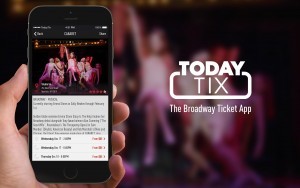 Now that mobile payments currently account for a little more than half of all e-commerce, mobile ticketing can also help increase revenue for ticket vendors and entertainment events alike. No-shows and empty seats are a thing of the past as mobile ticket providers can sell last second seats with the ability to sell tickets up minutes after an event starts. Plus, with no delivery fees, printing costs, or secret add-on surcharges, the customer and vendor both benefit from a secure transaction from a reputable and secure source, leaving scalpers and Ticketmaster in the dust.
Now that mobile payments currently account for a little more than half of all e-commerce, mobile ticketing can also help increase revenue for ticket vendors and entertainment events alike. No-shows and empty seats are a thing of the past as mobile ticket providers can sell last second seats with the ability to sell tickets up minutes after an event starts. Plus, with no delivery fees, printing costs, or secret add-on surcharges, the customer and vendor both benefit from a secure transaction from a reputable and secure source, leaving scalpers and Ticketmaster in the dust.
On today’s “Dot Complicated with Randi Zuckerberg” Randi talked the business of mobile ticketing with co-founders of TodayTix, Brian Fenty and Merritt Baer, as well as the CEO of Gametime, Brad Griffith.
BRIAN FENTY & MERRITT BAER of TODAYTIX
“The student rush line can take up to 25 times to finally get tickets that cost only $20 and the TKTS line you can wait for hours in snow and rain. We wanted to sell tickets in 30 seconds or less.”
“I think the dynamic pricing of tickets is something we’re seeing more and more. There are a lot of great discounts to be had.”
“In 2013, only .08% of Broadway tickets were mobile.”
“We launched a little over a month ago in the UK and have been completely embraced with open arms.”
“There are a lot of different ticketing agents in England, but none of them have tackled mobile.”
”Charlie and the Chocolate Factory is the biggest show people want to see in London.”
“People don’t just want to see the Lion King and Wicked. More folks are seeing more off-Broadway shows than ever as well.”
“We created a mobile lottery which we currently run for Fun Home who just won a bunch of Tony Awards.”
“Producers like lotteries because they entice more excited and engaging audience members.”
“A lot of trust comes from our app store reviews. We have over 2500 5-star reviews.”
“We also have a TodayTix concierge of actors that hand deliver your tickets to you up to 20 minutes before the show starts.”
“If you’re going to start something, do it with your best friend. When you have your best friend it makes the ride a whole lot better.”
“There’s a need to figure out how to use technology to have an ephemeral experience in theater, but we still need to unplug during the show.”
“The Yankees were a great time for me. When I was there I learned how to market to different demographics and younger people who didn’t want to spend $350 on season tickets.”—Brian Fenty
“There are 40 Broadway theaters owned by only 3 families. One of those companies owns Telecharge and one has a relationship with Ticketmaster. Both dominate the ticketing landscape.”
”We never take a website and cram it into a foreign screen to ensure a pleasurable customer experience.”
”Our customers respond well to our passion and experience in Broadway.”
”My favorite play, Curious Incident of the Dog in the Night Time and for musical is Something Rotten.”—Merritt Baer
”I love Hand to God in the play category. And Fun Home for musicals. It’s a hard ticket but worth it.”— Brian Fenty
”The apps I use every day are OpenTable, Uber and Instagram. I just deleted a wine recommendation engine but I wasn’t using it.”—Brian Fenty
”I love the New York Times app. It gives me great content on a daily basis. I recently deleted a museum app with content that only lives once.”—Merritt Baer
 BRAD GRIFFITH of GAMETIME
BRAD GRIFFITH of GAMETIME
“Gametime reimagines the game-going experience. You can pick the seats by their view + we curate the best 50 values we can find. Seamless & with zero printing.”
”I chance to work in baseball with Moneyball- style stats where I learned a ton about the numbers business.”
”We built a product for mobile from the ground up. Giants fans loved it. We took the data and showed it to investors to get the first round of investing.”
”Sports owners are looking for people doing interesting things within the sports industry.”
”13% of people don’t show up and are too busy to sell their tickets or give them to a friend. That’s where we come in.”
”The tickets come from teams, larger sellers, and fans then all those entities set their prices. Those prices change every 10 seconds in real time.”
“We only show 50 of the best values out of 5,000 candidate options.”
“We sell up to 90 minutes after start time, but 15 minutes before the event starts is really the sweet spot to buy.”
“We thought about putting scores into sale prices. Weather definitely affects prices.”
“Sports are hyper-social. You never really go alone.”
“The experience is better on mobile. It’s easier to purchase and go.”
“92% of our buyers in June heard about us from a friend.”
“AT&T Park remains a favorite of mine. Wrigley Field, the Seattle Mariners Safeco Field and Fenway are all my top 4 stadiums.”
“We make sure our first impression is one of trust. We put the fan experience at the forefront in all we do.”
“Think about an experience that you’ve had, what’s new to what’s happening in the world, and create your own Venn diagram into the intersection of the two to figure out the kind of company you want to create.”
“I’m a huge fan of Lyft and HotelTonight, who invested in Gametime as well. I think I have the most apps of any iPhone.”—Brad Griffith
Make sure to join “Dot Complicated with Randi Zuckerberg” every Wednesday on SiriusXM Business Channel 111 9am PT/12 ET!!



 by
by 
The post Radio Recap: Mobile Tickets appeared first on Dot Complicated.
July 29, 2015
Radio Recap: Travel Apps
 Currently over 60% of smartphone owners have downloaded some sort of travel-related app. Of those, 30% have booked a last minute reservation from their phone and 24% of both business and leisure travelers have paid for their trip via mobile, all totaling an estimated $150 billion dollars spent in just mobile bookings alone.
Currently over 60% of smartphone owners have downloaded some sort of travel-related app. Of those, 30% have booked a last minute reservation from their phone and 24% of both business and leisure travelers have paid for their trip via mobile, all totaling an estimated $150 billion dollars spent in just mobile bookings alone.
Today Randi discussed how to monetize mobile applications within the billion-dollar industry of business travel with two major app developers: AJ McGowan, co-founder and CTO of travel service DUFL, and Jared Kons developer of Bug Spray, a mobile application that repels mosquitos.
“I like bringing consumers a better experience.”
“DUFL is a premium travel service geared toward business travelers.”
“It’s the closet in the cloud.”
“The genesis moment for us was on a business trip from London to Phoenix. We said there’s got to be a better way to do this.”
“We just launched on Android last week to a big waiting list of people ready to sign up.”
“Word of mouth works best. Business travelers are a tight knit community.”
“Entrepreneurship is the most exciting thing in the first few weeks and months.”
“We were really focused on key technical aspects in building DUFL.”
“We’re big believers of intellectual property. It should be a part of your strategy, even if it’s only from a defensive perspective.”
“The most important thing for hotels is the business traveler. As well as for the airlines.”
“Everything front to back is set up as a premium experience. All our handlers come mostly from retail and our facilities are under extreme security.”
“Instead of spending two hours to go grocery shopping, I can now do everything from my phone and have it delivered.”
“When people open up that suitcase it’s a complete game changer.”
“Bug Spray emits a high frequency tone to help repel insects and pests.”
“The frequency emits a higher tone than most people can hear.”
“I developed another application that uses tones humans can’t hear but dogs can.”
“This range is within the human hearing range but as we age we lose the high frequency tones. I can’t hear anything above 17 kilohertz.”
“Word of mouth is a powerful marketing tool.”
“I work with developers and large companies on how to protect themselves and their ideas.”
“There’s been an explosion of software patents since the App Store. It makes it tricky to get a patent going forward.”
“The app has had almost 2 million downloads.”
“I had an app that was pulling GPS coordinates all the time, wasting battery power, so I had to delete it.”
Favorite travel apps from callers:
Les from Texas: “I’m an over-the-road truck driver, I use Fuelbook, the best fuel prices on the route.”
Matt from Michigan: “I do a lot of last minute traveling so my favorite is Hotel Tonight. One improvement I’d make is to search the best deal along your route.”
Michael from TN: “I use the ITA Matrix app for all my travel. It’s the software the travel agents use to find routing information.”
Make sure to join ‘Dot Complicated with Randi Zuckerberg’ next week when Kelly McGann, the CMO Sears Connec ted Solutions, and Alexis Rask, Chief Revenue Officer of Shopkick join the show. Wednesdays at 9am PT/12 ET on SiriusXM Business 111. And don’t forget to call in with your questions for Randi or her guests LIVE at 1-800-WHARTON.



 by
by 
The post Radio Recap: Travel Apps appeared first on Dot Complicated.
July 24, 2015
Radio Recap: Bitcoin
 As is stands now, two-thirds of all in-person transactions are made through credit cards, which reveals your name and address with every sale transacted. Credit cards are regularly hacked so much so that 1/3 of all online credit card transactions in London are fraudulent. Credit card companies also rack up over $50 billion dollars in fees yearly of your money, whereas with Bitcoin, if you lose your password or get tricked into spending your money foolishly it’s like losing cash, never to be retrieved again. With currently 2.5 billion people worldwide without a banking account, by using digital currencies such as Bitcoin, all one needs is a mobile phone and the internet. Meaning that the people themselves can now be their own bank.
As is stands now, two-thirds of all in-person transactions are made through credit cards, which reveals your name and address with every sale transacted. Credit cards are regularly hacked so much so that 1/3 of all online credit card transactions in London are fraudulent. Credit card companies also rack up over $50 billion dollars in fees yearly of your money, whereas with Bitcoin, if you lose your password or get tricked into spending your money foolishly it’s like losing cash, never to be retrieved again. With currently 2.5 billion people worldwide without a banking account, by using digital currencies such as Bitcoin, all one needs is a mobile phone and the internet. Meaning that the people themselves can now be their own bank.
Today Randi discussed digital currency and Bitcoin with Paul Vigna and Michael Casey, authors of “The Age of Cryptocurrency: How Bitcoin and Digital Currency are Changing the Global Economic Order.” Also joining the show is Torsten Hoffmann, the writer, director and producer of Bitcoin documentary, “Bitcoin: The End of Money as We Know It.”
“You still get a lot of people who’ve never heard of Bitcoin. For us that was one of the motivations to write the book.”
“We both have come to believe that this is a real innovation that’s going to have a very large impact.”
“On a financial front, on a societal level, on a technology level, Bitcoin is making an impact.”
“Nobody in the Bitcoin world is encouraging you to do elicit things online.”
“Your identity within your Bitcoin account is encrypted. Your transactions are completely in the public record.” To caller @sodahead
“Bitcoin is more pseudonymous than anonymous.”
“The easiest way to make money from Bitcoin is write a book or produce a documentary. If you’re tech savvy, create a business.”—To caller Gerald
“Early 2013 was the first time I heard about Bitcoin. I remember thinking it was a scam. I resisted putting in the Wall Street Journal.”
“You’re going to see more and more security measures coming.”
“There’s so many different angles and rabbit holes you can jump down with Bitcoin.”
“Where Bitcoin intersects with the sharing economy is most interesting. It’s part of a much larger technology-based shift in aspects of social media and finance.”
“I wouldn’t recommend using Bitcoin as a sole currency. But using it as an additional currency you brand yourself as a company who’s ‘with it.”— To caller Joceylyn from SF
“At the very least start thinking about the money in your wallet. What does it represent? Bitcoin raises those questions that too few people ask.”
“When you say what Bitcoin actually is, it’s so unsexy. It’s a ledger, a record of transactions that lies on multiple computers.”
“We’re available to digitally transfer money to a stranger that we know cannot be counterfeited. All without a third party or without residing in a bank.”
“With Big Data tools all this tracking is going to be much more sophisticated in terms of security.”
“Criminals are mainly doing business in paper cash, not Bitcoin.”
“The upside to Bitcoin is there’s so many others ways the ledger that can be used. Eventually the demand for the coins will rise.”
“It’s a binary bet, it’s all or nothing.”
“We have the 5 stages of Bitcoin: Dismissal, Distain, Curiosity, Eureka!, and Acceptance.”
“There’s definitely criminal activity behind Bitcoin, but there’s massive cyber attacks across our economy everywhere.”
“Bitcoin as a ledger is un-hackable.”
“In regards to micropayments, Bitcoin doesn’t care about the size of the payment.”—To caller Michael from Boston
“People are thinking about ad revenue sharing. Taringa, the Facebook of South America, has 75 million users. They share their ad revenues through Bitcoin.”
“We have a chapter called ‘Everything Blockchain’, or Bitcoin 2.0. There’s so many other use cases for this ledger.”
“We can place our deeds and put them on the blockchain by a decentralized group of computers. You don’t need trustees. It’s more efficient.”
“With Bitcoin you can get credit card processing fees down from 3% to 1%.”
“The ability to keep a seamless record of how money is moving the system is where the power lies.”
“Bitcoin is an option, an alternative. Gold has persisted for years. Bitcoin will bring competitive pressure to our current global currency issues.”
“This is a platform that can decentralize the way we do commerce. It’s quite profound.”
“With the blockchain you’re traceable until the end of time.”
“Paper money is decreasing in value through deflation. Bitcoin will be more valuable because there will be fewer available over time.”
“When you first hear about Bitcoin you completely ignore it and shrug it off. But eventually you see it more and more and begin researching. My way to deal with this was to produce a film.”
“Bitcoin is such a complicated topic that most people don’t understand it by reading about it.”
“I approached the documentary like a startup. The Kickstarter paid for about 20% of the film, the rest funded by me.”
“Small businesses worry about the volatility, but Bitcoin directly converts into whatever currency you want.”
“Bitcoin lets you be in control of your money. The people in Greece can’t go into their bank accounts and get their own money.”
“All the problems that we see with inflation in Argentina or Greece can be fixed by crypto-currencies.”
“This film is not for people who own Bitcoin. It’s for people who don’t understand it.”
“Investigate an hour or two into one of the most technological advancements in our time.”
“Now I’m selling my documentary through Bitcoin.”
Join ‘Dot Complicated with Randi Zuckerberg’ next week when she talks to app developers of ultrasonic mosquito repellent Bug Spray and travel concierge DUFL . Randi will also be taking calls for listeners to discuss their Favorite Travel Apps!
Only on SiriusXM Business111 12pm ET/9am PT. Call in at 1-800-WHARTON!



 by
by 
The post Radio Recap: Bitcoin appeared first on Dot Complicated.
Technology and Avoidance
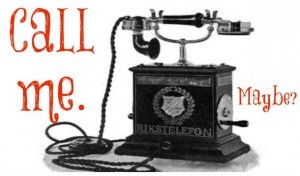 Making Phone Calls When a Text is so Much Easier.
Making Phone Calls When a Text is so Much Easier.
By Dawn Rebel
Bad news, anxiety, cranky family members — there are endless reasons to avoid making phone calls. The hand-held convenience of instant messaging, email, and text has given us another way to avoid the person-to-person contact that comes with picking up the phone and actually talking to a real, live, responding, human being.
There are some messages that just cannot — must not — be delivered by email or text message. Bad news, breaking up, making contact for job prospects, interacting with specific or perspective clients, and even asking how your mom is doing: these things all fall into the category of “you just gotta pick up the damn phone.”
Trust me on this. I have had experience doing this poorly. *cough, breakup text, cough*
Having worked in politics, a profession all about people, I also have had experience doing this well. Sometimes, you just have to make a call you don’t want to.
Coping with your phone discomfort by avoiding it is never in your best interest. According to Psychology Today “Avoidance coping creates stress and anxiety, and ravages self-confidence. It’s is a major factor that differentiates people who have common psychological problems (e.g., depression, anxiety, and/or eating disorders) vs. those who don’t.”
Plus, if you’re a parent, modeling good phone skills is an important teachable for the little listening ears at home. My 18-month-old can already imitate me on the phone. It scares me somethin’ fierce.
So, how do you jump the annoying hurdle of making phone calls? All it takes is a little preparation, some “jumping in,” followed by a pat on the back:
PREPARATION
Prepare for your call by writing down some key information: whom you are calling, what you are calling about, and what “key messages” you want to deliver.
Key messages do not need to be written like a speech. In fact, bullet notes will serve you best. For example:
 Our company is looking to host a joint event with you. Are you interested?
Our company is looking to host a joint event with you. Are you interested?
 We promised my husband’s parents we would have Christmas with them this year.
We promised my husband’s parents we would have Christmas with them this year.
 I’m not able to make the minimum payment right now. Is there any way you can help me better manage this account?
I’m not able to make the minimum payment right now. Is there any way you can help me better manage this account?
Some light preparation will make you feel more in-control of the situation. You will be less likely to sidetrack, or forget your reason for calling in a moment of fluster.
“JUMPING IN”
Grab the Nike motto and “Just Do It.” Overthinking a phone call can lead you to further excuses not to make it.
So, choose a time in your day when you have limited distractions. Find a quiet location, and put your “tools” in front of you. Your tools being:
 A pen and paper, or/and
A pen and paper, or/and
 Your computer, or/and
Your computer, or/and
 Your calendar
Your calendar
Some people like to stand and pace while on the phone, while others prefer to sit and take notes. Do what makes you the most comfortable!
Start the call with the right attitude. In most cases smiling while the line is ringing is a great pre-call strategy: fake it till ya make it.
If your reason for calling is bad news, deliver it right away. Small talk rarely lubricates a challenging conversation. Rip off that Band-Aid.
PAT ON THE BACK
You’re done! You are such an urban warrior. Now you get to reinforce your success by reminding yourself of the positive outcomes of the call: Did you get what you asked for? Did you make a new contact? Did you handle a tough situation with grace and poise?
No matter what actually happened on the phone, you need to recognize your development of a dying skill. Modern technology has enabled our avoidance of person-to-person contact. We are more and more afraid to actually speak to a human being.
When I was a teenager, I hated making phone calls to the point that I would often attempt to enlist my mother to do the dirty work (the shame!). My mom was clever enough to see my discomfort and refuse, saying, “What’s the worst that could happen? They say NO?” They aren’t going to beat you…”
I’ve made many phone calls in my life, and mom has been right. So far, no beatings.
Also, very few NOs.



 by
by 
The post Technology and Avoidance appeared first on Dot Complicated.
July 23, 2015
6 Ways to Get the Most Out of Online Workout Classes
 With so many virtual-training programs and workout videos available online (including ours soon!), you can pretty much skip the gym whenever you want—without slacking on your fitness. But online workouts can be easier said than done. Where do you put your laptop? The couch is right there.
With so many virtual-training programs and workout videos available online (including ours soon!), you can pretty much skip the gym whenever you want—without slacking on your fitness. But online workouts can be easier said than done. Where do you put your laptop? The couch is right there.
Here are the best ways to get motivated at home and get your sweat on in front of a computer.
Commit to a workout space.
Maybe it’s the garage, the backyard, or even the kitchen. Pick a designated workout spot, and stick with it. You’ll start to associate that location with working out, which will make it easier to establish a routine. Try to avoid carpeted spaces—you’ll feel more like napping than running in place—but use a yoga mat to soften up tile or hardwood floor. Move area rugs (or anything else you might trip over) out of the way.
Be wary of low ceilings if your workout involves any jumping. To see if you’ll have enough room, lie down on the floor and make sure you have room to stretch out your arms and legs. Then, take one wide step out to each side. If you’re doing a cardio or dance-oriented video, you may want a little extra space beyond that. Home-workout success is about working with the room you have. A video might say to take three leaps to the side, but you might only have room for two—and that’s okay.
Make sure you can see your laptop.
If you’re doing a workout in which you’ll be standing and lying on the floor, like yoga, position your laptop on a small step, a low table (like a coffee table), or even on a stack of books. If you put your laptop too close to eye-level (like on a countertop), you won’t be able to see a thing when you’re down on your mat.
For strength-based or cardio videos where you’ll be mostly on your feet, put your laptop on something halfway between eye-level and your waist (try a desk or the kitchen table).
The most important part of your laptop set up is bumping the volume all the way up. For some moves, you might not be facing the screen head-on. You need to be able to hear the instructor loud and clear.
Give yourself some prep time.
When you go to the gym, the drive or walk there is your mental prep time. When you roll out of bed or stroll into the kitchen, your mind may need an extra kick to get into workout mode. Play a few pump-up jams before starting the video to get motivated and focused, and make it a part of your routine.
Get a (virtual) workout pal.
Working out with a friend can be a major motivation booster, but it’s tricky to do when you’re working out at home. Even if you don’t have the time or space to follow a workout video together, you can commit to doing a particular workout on the same day—and hold each other accountable to make sure you get it done. When you know your pal will be doing the same video as you and that they’ll probably want to compare notes afterward, your investment in your solo living-room workout skyrockets.
Research the instructor.
Everyone and their 15-year-old sister has a YouTube channel, so make sure you research the instructor of any online workout you want to try. Quality experts and brands are aware that you’re doing this video at home without supervision and take that into consideration when designing the workout.
Try to look out for an instructor who’s certified. Look for personal training certifications like: C.S.C.S. [certified strength and conditioning specialist], C.P.T. [certified personal trainer], or a certification through A.C.E. [the American Council on Exercise], when you’re doing a strength or cardio workout.
If you’re doing a yoga video, check for an instructor who has at least 200 hours of training.
Even though the quality of the video instructor is important, your bottom line is whether you can follow along. Remember: if you’re having trouble keeping up with the video, it’s not your fault—it’s the video’s! Search for another one until you find a workout that you feel safe and comfortable doing.
Check your form throughout the video.
As you’re doing the workout itself, make sure you stay in tune with your body and how you’re moving. In a group class or training session at the gym, the instructor can provide feedback and fix your form when needed. Though video instructors will often explain what muscles a move works and demonstrate proper form, the final responsibility to do it right is all on you.
If you’re doing a squat, for example, make sure to ask yourself, ‘Where am I feeling this move? Am I keeping my core tight? Am I sitting back and pushing up through my heels?’ Check in on what muscles feel the burn to make sure you’re performing an exercise properly. (If you don’t feel anything or a different area feels like it’s being worked than what you’re supposed to be focusing on, it’s a good sign you need to adjust your form.) If you have a mirror that you can position near your workout space, use it to check in on your form, especially if you’re trying out a move that’s new.
And again: If at any point you really can’t follow along with a move or you feel pain, take it as a red flag that this particular video might not be a good match for you.



 by
by 
The post 6 Ways to Get the Most Out of Online Workout Classes appeared first on Dot Complicated.



